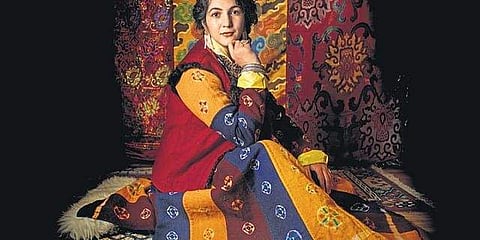
- LIFESTYLE
- FASHION
- FOOD
- ENTERTAINMENT
- EVENTS
- CULTURE
- VIDEOS
- WEB STORIES
- GALLERIES
- GADGETS
- CAR & BIKE
- SOCIETY
- TRAVEL
- NORTH EAST
- INDULGE CONNECT

There is a saying in Ladakh that weaving textile is associated with fertility—the warp is the mother and the weaver inserts the weft to make cloth, which is metaphorically the child conceived within her womb. Very appropriate considering that much of the economy is based on wool, considered the best in the world, stimulated as it is by the intense winter cold of windswept plateaus and high altitudes. The softest wool is used in apparel and accessories, the coarser varieties in furnishings. Nothing is wasted because of the reverence for textile—the remaining material from dehairing is used for felting.
This is the great tradition that Jigmat Norbu and Jigmet Wangmo of Leh-based Jigmat Couture continue. Calling themselves ‘cultural fashion artists’ rather than fashion designers, they base their design philosophy on Ladakhi art, craft and culture. Most designers in India and abroad produce a minimum of three collections annually, but Jigmat Couture does a single one, using only Ladakh textiles. Their creative process is based on an intense study of a particular region and its historicity and culture. The collection is accompanied by research on paper, drawings, oral and video recordings that form their very own textile museum, giving it a gravitas that raises it above mere fashion.
The Jigmat duo studied fashion at NIFT and worked in mainstream fashion for a decade, realising in 2010 that they could channel Ladakhi expertise in weave and design to create a textured, warm and durable product. As they say, “The outcome was beyond expectation.” They are intensely proud to run a business with a conscience, one that breathes Ladakh and follows an ethical and sustainable manufacturing process.
They continue the use of the traditional foot loom, the backstrap loom and the fixed heddle loom, but as designers, have innovated in silhouette and drape, making the historical contemporary and wearable. They feel that they have transformed the local wool fibre into an exceptional product that links remote Ladakh to the international luxury market. The product is free from harmful chemicals and safe for the skin and the environment. Best of all, the duo ensures fair wages to the artisans, generates local economies and upcycles textile waste.
In 10 short years, Jigmat Couture has a chain of stores in Ladakh, an online presence, and stock in several international stores. But what they are proudest of are the three projects they are working on currently. ‘Art & Artisans’ provides training and workshops to people interested in the native loom. The Textile Museum of Ladakh preserves Ladakhi art, craft and culture for posterity. The Artisanal Residency project is about to finish next year and is slated to be a unique space for artists visiting Ladakh who might collaborate with Jigmat Couture.
When queried about expansion plans, the duo characteristically says that they would rather take it slow, but are experimenting with furnishings made on the backstrap loom. Participating in Fashion Week, which is usually an ambition for designers, does not make sense for them, as production is limited and they produce only one collection a year.
Eventually, they hope that their spirit of entrepreneurship and excellence will influence other Ladakh entrepreneurs to promote local craft and create job opportunities. Change the way that India and the rest of the world look at Ladakh. They are well on the way to achieving this ambition.